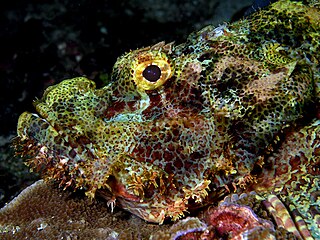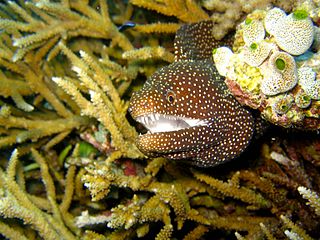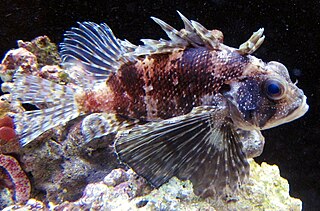
The Scorpaenidae are a family of mostly marine fish that includes many of the world's most venomous species. As their name suggests, scorpionfish have a type of "sting" in the form of sharp spines coated with venomous mucus. The family is a large one, with hundreds of members. They are widespread in tropical and temperate seas but mostly found in the Indo-Pacific. They should not be confused with the cabezones, of the genus Scorpaenichthys, which belong to a separate, though related, family, Cottidae.

Moray eels, or Muraenidae, are a family of eels whose members are found worldwide. There are approximately 200 species in 15 genera which are almost exclusively marine, but several species are regularly seen in brackish water, and a few are found in fresh water.

Synanceia verrucosa, the reef stonefish or simply stonefish, is a species of venomous, marine ray-finned fish, belonging to the subfamily Synanceiinae which is classified as being within the family Scorpaenidae, the scorpionfishes and their relatives. It is the most widespread species of stonefish, mostly found in shallow waters of the Red Sea and the Indo-Pacific. It is the deadliest fish in the sea, with highly effective venom which can be lethal to humans.

The mimic octopus is a species of octopus from the Indo-Pacific region. Like other octopuses, it uses its chromatophores to disguise itself with its background. However, it is noteworthy for being able to impersonate a wide variety of other marine animals. Although many animals mimic either their environment or other animals to avoid predation, the mimic octopus and its close relative the wunderpus are the only ones known to actively imitate several animals in order to elude predators.

The red lionfish is a venomous coral reef fish in the family Scorpaenidae, order Scorpaeniformes. It is mainly native to the Indo-Pacific region, but has become an invasive species in the Caribbean Sea, as well as along the East Coast of the United States and East Mediterranean and also found in Brazil at Fernando de Noronha.

Dendrochirus biocellatus, the twospot turkeyfish, twinspot lionfish, twoeyed lionfish or ocellated lionfish, is a species of marine ray-finned fish belonging to the family Scorpaenidae, the scorpionfishes and lionfishes. This species is widespread throughout the tropical waters of the Indo-West Pacific region, In the wild, the species eats small fish as well as shrimp.

The striated frogfish or hairy frogfish is a species of marine ray-finned fish belonging to the family Antennariidae, the frogfishes. This species is found in the Indo-Pacific and eastern Atlantic Ocean.

Dendrochirus is a genus of marine ray-finned fishes belonging to the family Scorpaenidae, the scorpionfishes. They are mostly known as turkeyfishes or pygmy lionfishes. They are native to the Indian and Pacific Oceans. They are also popular aquarium fish.

The decoy scorpionfish is a species of marine ray-finned fish belonging to the family Scorpaenidae, the scorpionfishes. It is native to the Western Indian and Pacific oceans. A non-migratory species, I. signifer can be observed in close association with coral reefs at depths of from 10 to 70 metres. This species grows to a length of 13 centimetres (5.1 in) TL. This species is the only known member of its genus and can be distinguished by its unique prey-luring behavior.

Pterois miles, the devil firefish or common lionfish, is a species of ray-finned fish native to the western Indo-Pacific region. It is frequently confused with its close relative, the red lionfish. The scientific name is from Greek pteron, meaning "wing", and Latin miles, meaning "soldier".

Pterois antennata, the spotfin lionfish, banded lionfish, broadbarred lionfish, broadbarred firefish, raggedfinned firefish, raggedfinned scorpionfish or roughscaled lionfish, is a species of marine ray-finned fish belonging to the family Scorpaenidae, the scorpionfishes and lionfishes. It is found in the tropical Indian and Western Pacific Oceans.

Dendrochirus brachypterus, the dwarf lionfish, short-finned turkeyfish, shortspine rockcod or shortspine scorpionfish, is a species of marine ray-finned fish belonging to the family Scorpaenidae, the scorpionfishes and lionfishes. It is found in the Indo-Pacific. It is sometimes found in the aquarium trade.

Dendrochirus barberi, the Hawaiian lionfish or green lionfish, is a species of marine ray-finned fish belonging to the family Scorpaenidae, the scorpionfishes and lionfishes. It occurs in the Eastern Central Pacific. It occasionally makes its way into the aquarium trade.

Coral reef fish are fish which live amongst or in close relation to coral reefs. Coral reefs form complex ecosystems with tremendous biodiversity. Among the myriad inhabitants, the fish stand out as colourful and interesting to watch. Hundreds of species can exist in a small area of a healthy reef, many of them hidden or well camouflaged. Reef fish have developed many ingenious specialisations adapted to survival on the reefs.

The roving coral grouper, also known as the spotted coral grouper, is a species of marine ray-finned fish, a grouper from the subfamily Epinephelinae which is part of the family Serranidae, which also includes the anthias and sea basses. It is found in the Indo-Pacific, although the Red Sea taxon, P. marisrubri, is regarded as a separate species by some authorities.
The Andover lionfish is a species of marine ray-finned fish belonging to the family Scorpaenidae, the scorpionfishes and lionfishes. It is found in the western Pacific Ocean.

Pterois sphex, the Hawaiian turkeyfish or Hawaiian lionfish is a species of ray-finned fish with venomous spines belonging to the family Scorpaenidae, the scorpionfishes and lionfishes. It is found in the eastern Central Pacific, specifically in marine waters off of Hawaii. It is found in seaward reefs and lagoons at depths from 3 – 122 m.

Pterois russelii, the largetail turkeyfish, plaintail firefish, plaintail turkeyfish, Russell's firefish, Russell's lionfish, spotless butterfly-cod or the spotless firefish, is a species of ray-finned fish with venomous spines belonging to the family Scorpaenidae, the scorpionfishes and lionfishes. It is native to the Indo-Pacific Ocean from the eastern part of Africa to the Persian Gulf.

Pterois is a genus of venomous marine fish, commonly known as lionfish, native to the Indo-Pacific. It is characterized by conspicuous warning coloration with red or black bands, and ostentatious dorsal fins tipped with venomous spines. Pterois radiata, Pterois volitans, and Pterois miles are the most commonly studied species in the genus. Pterois species are popular aquarium fish. P. volitans and P. miles are recent and significant invasive species in the west Atlantic, Caribbean Sea and Mediterranean Sea.

Scorpaenopsis diabolus, the false stonefish, false scorpionfish or the devil scorpionfish, is a species of venomous marine ray-finned fish belonging to the family Scorpaenidae, the scorpionfishes. It has venomous spines and lives in the tropical Indian and Pacific Oceans as well as in the Red Sea. It is a bottom-dwelling predator that relies on its camouflage to catch passing prey.



















